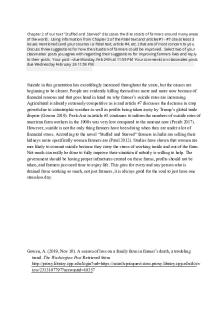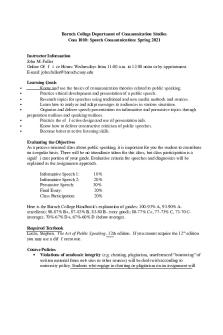Phil 1010 - Turing Response PDF

| Title | Phil 1010 - Turing Response |
|---|---|
| Author | destiny |
| Course | Critical Thinking |
| Institution | Georgia State University |
| Pages | 1 |
| File Size | 47.7 KB |
| File Type | |
| Total Downloads | 42 |
| Total Views | 162 |
Summary
Turing Response
...
Description
Turing Response PHIL 1010
Can machines think? Turing wanted to propose an experimental test to see if something is intelligent and gives us, in theory, a question that we can answer. To sum up The Imitation Game, there are two rooms. In one room there is a man classified as “A” and there a woman classified as “B”. In the other room there is an interrogator who is classified as “C”. The interrogators job is to decide which of the two in the other room is the man and the woman. The interrogator determines this through typewritten communication. The man’s goal is to cause the interrogator to make the incorrect identification and the woman's goal is to help the interrogator to make the correct identification. The objective is to see if the interrogator will decide incorrectly as much as a machine. While reading this piece I learned that the best strategy for the woman is to provide honest answers. The problem with this game is that it ignores the physical capacities of human beings . A computer does not have a mind which means it is not conscious or self-conscious. A computer can not create something from thoughts and emotions so it cannot be equal to a brain. Turing wanted to show that the practical account of thinking can be realized in different ways. Machines can not be nice, empathetic, beautiful, kind, take initiative, funny, fall in love, make mistakes, etc. Jefferson’s take on the machine is that no mechanism can feel pleasure at its successes or failures nor can if feel grief, be welcomed by flattery, or be angry, sad or depressed when it cannot get what it wants. Ultimately, machines do what they are programmed to do....
Similar Free PDFs

Phil 1010 - Turing Response
- 1 Pages

Phil 1010 Syllabus TR 2.15 (18680)
- 11 Pages

Application for turing machine
- 5 Pages

Turing Machine and PDA Notes
- 15 Pages

Variants of turing machines
- 2 Pages

Business Case: Turing Pharmaceutical
- 23 Pages

AG 1010
- 2 Pages

Máquina de Turing
- 6 Pages

Turing Paper 1936
- 36 Pages

Prueba de Turing
- 1 Pages

COM 1010 Syllabus
- 12 Pages

English-1010-handbook
- 68 Pages
Popular Institutions
- Tinajero National High School - Annex
- Politeknik Caltex Riau
- Yokohama City University
- SGT University
- University of Al-Qadisiyah
- Divine Word College of Vigan
- Techniek College Rotterdam
- Universidade de Santiago
- Universiti Teknologi MARA Cawangan Johor Kampus Pasir Gudang
- Poltekkes Kemenkes Yogyakarta
- Baguio City National High School
- Colegio san marcos
- preparatoria uno
- Centro de Bachillerato Tecnológico Industrial y de Servicios No. 107
- Dalian Maritime University
- Quang Trung Secondary School
- Colegio Tecnológico en Informática
- Corporación Regional de Educación Superior
- Grupo CEDVA
- Dar Al Uloom University
- Centro de Estudios Preuniversitarios de la Universidad Nacional de Ingeniería
- 上智大学
- Aakash International School, Nuna Majara
- San Felipe Neri Catholic School
- Kang Chiao International School - New Taipei City
- Misamis Occidental National High School
- Institución Educativa Escuela Normal Juan Ladrilleros
- Kolehiyo ng Pantukan
- Batanes State College
- Instituto Continental
- Sekolah Menengah Kejuruan Kesehatan Kaltara (Tarakan)
- Colegio de La Inmaculada Concepcion - Cebu



